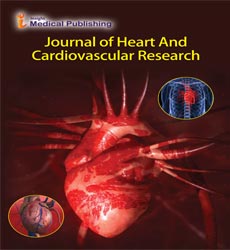ISSN : ISSN: 2576-1455
Journal of Heart and Cardiovascular Research
Systemic Right Ventricle in Congenital Heart Disease: Arrhythmia Mechanisms and Clinical Considerations
Victor Bartoletti*
Department of Cardiology, Harvard University, Boston, USA
- *Corresponding Author:
- Victor Bartoletti
Department of Cardiology, Harvard University, Boston,
USA,
E-mail: bartolettiV@yahoo.com
Received date: May 06, 2024, Manuscript No. IPJHCR-24-19366; Editor assigned date: May 09, 2024, PreQC No. IPJHCR-24-19366 (PQ); Reviewed date: May 24, 2024, QC No. IPJHCR-24-19366; Revised date: May 31, 2024, Manuscript No. IPJHCR-24-19366 (R); Published date: June 07, 2024, DOI: 10.36648/2576-1455.8.2.67
Citation: Bartoletti V (2024) Systemic Right Ventricle in Congenital Heart Disease: Arrhythmia Mechanisms and Clinical Considerations. J Heart Cardiovasc Res Vol.8 No.2: 67.
Description
Congenital Heart Disease (CHD) is often associated with Systemic Right Ventricle (SRV), which is the morphological right ventricle that supports systemic blood flow. The pathophysiology of SRV ventricular arrhythmias is not yet fully understood and there may be differences between CHD subtypes. Although these events are rare, they are difficult to predict. This review discusses current strategies for risk assessment and prevention of ventricular arrhythmias in patients with SRV. A recent risk stratification model combines independently related factors into risk scores and pulmonary Left Ventricular (LV) dysfunction appears as a critical factor in risk assessment. Cardiac MRI, biomarkers and genetic information may improve the ability to predict ventricular arrhythmias in SRV. However, the question of whether Implantable Cardioverter Defibrillators (ICD) should be used as a preventive measure in this group remains unanswered. Multicenter studies are needed to assess risk patterns and ICD use in this aging population. Because ICDs have disadvantages such as high rates of inappropriate shocks and late lead-related complications, shared clinical decision-making is critical when considering their use. The review emphasizes the need for further research in this area to improve the identification of patients at clinical risk of ventricular arrhythmias and to develop effective prevention strategies.
SRV dysfunction
SRV, defined as a morphological right ventricle that supports systemic blood flow, is relatively common in CHD, affecting approximately 10% of all forms of coronary artery disease. The most common anatomical defects in which SRVs occur are complete transposition of the great arteries with previous atrial septal repair and congenital transposition of the great arteries. This anatomy is also present in hypoplastic left heart syndrome relieved by the Norwood-Fontan protocol, dual inflow right ventricle and dual outflow right ventricle, usually with prior fontan relief. Regardless of the underlying cardiac anatomy, patients with SRV have a worse prognosis than patients with systemic LV. Arrhythmias, SRV dysfunction, heart failure and sudden cardiac death are important late complications. Patients with SRV, particularly those with Dextro Transposition of the Great Arteries (D-TGA) and AV repair, are among those with coronary artery disease at highest risk for Sickle Cell Disease (SCD). Information on primary prevention and thus the distribution of risks associated with ICD implantation remains scarce, so patient selection and timing remain difficult. This article provides an update on the mechanisms of Ventricular Arrhythmias (VA), risk stratification approaches for VA and SCD in patients with SRV and treatment and prevention of VAs in patients with SRV. Sudden cardiac death is the most common cause of death in SRV after heart failure, accounting for 16%-20% of deaths. In the recent Major Adverse Ventricular Arrhythmias and Related Events (MAREs). European cohort of adults with SRV, events including SCD, sustained Ventricular Tachycardia (VT) and appropriate ICD therapy were reported in 5% of patients during the median follow-up period. 9 years and an incidence of 6.3 cases per 1000 patient years.
Arteriovenous replacement
The incidence of Arrhythmias and Related Events MAREs increased with age and occurred at a younger age in D-TGA patients with atrial bypass, suggesting a difference in the pathophysiology of VAs between D-TGA and Levo-Transposition of the Great Arteries (L-TGA). D-TGA is one of the most common cyanotic heart defects in newborns, occurring in approximately 1 in 3,000 live births. Radical surgery in the form of atrial exchange was routinely performed in the 1960s and 1970s and was gradually replaced by arteriovenous replacement in the 1980s. The latter operation restores the left ventricle to a sub-aortic position, so that only the subset of older D-TGA patients with mustard or senning repair have SRV. These patients are now adults, enabling long-term follow-up. D-TGA relieved by atrial exchange is one of the congenital heart defects with the highest risk of SCD. In a population-based study, the incidence was 4.9 per 1,000 patient-years, second only to aortic stenosis and more than three times higher than tetralogy of fallout. L-TGA is an even rarer congenital heart defect, accounting for approximately one in 33,000 live births. The incidence of sudden death due to documented VAs, which accounts for 10%-15% of all L-TGA deaths, has been estimated to be 1.8%-25% per 1000 patient years.
Open Access Journals
- Aquaculture & Veterinary Science
- Chemistry & Chemical Sciences
- Clinical Sciences
- Engineering
- General Science
- Genetics & Molecular Biology
- Health Care & Nursing
- Immunology & Microbiology
- Materials Science
- Mathematics & Physics
- Medical Sciences
- Neurology & Psychiatry
- Oncology & Cancer Science
- Pharmaceutical Sciences
